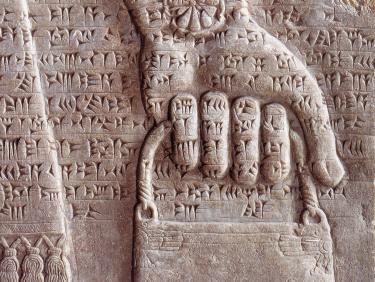Faculty of PhilosophyAssyriology
The Assyriology (Ancient Near East Studies) degree programme focusses on the Sumerian, Babylonian, Assyrian and Hittite cultures in their entire impressive diversity.
Assyriology (also known as Ancient Near Eastern Philology) focusses on the study of the high cultures of the ancient Near East, examining their languages, history, religion, science, literature, economy, societies, and legal systems. Key to the understanding of the languages and cultures of the ancient Near East is cuneiform script. Cuneiform script emerged towards the end of the fourth century B.C.E. in southern Mesopotamia, the area between the Euphrates and Tigris rivers that today is part of Iraq. For over three millennia, cuneiform script was the prevailing system of writing in the Near East, serving as the written form for a number of different languages: Sumerian and Akkadian in Mesopotamia, the Hittite language in Anatolia, and the Elamite language in Iran, as well as other languages. At the dawn of the Common Era, cuneiform was replaced by the Aramaic and Greek scripts. The ancient Near East cultures were assimilated into the Hellenistic culture. Nevertheless, their enormous influence on the Greco-Roman and Judeo-Christian cultures has had a significant impact on the modern world-view, including religion and science.

Special Features and Characteristics
Heidelberg University was among the first universities in Germany to recognise the need to include Assyriology in the university’s range of course offerings. The first Assyriologist at the university (Carl Bezold [1859–1922]) was appointed in 1894. The current Assyriology Department includes two professorships (Professor of Assyriology; Professor of Assyriology with a focus on Sumerology) and a position for an academic advisor. The department is part of the Department of Languages and Cultures of the Near East, which also includes a Semitic Studies Department and an Islamic Studies Department.
The Assyriology Department not only possesses one of the leading ancient Near East libraries in the world, but also is in possession of collections that are highly relevant for research. The Uruk-Warka Collection, for instance, contains approximately 2,000 cuneiforms, which have only been partially researched, and which are illustrative of the over 3,000-year-old history of ancient Near Eastern scripts.
Research
The Assyriology Department is a very active centre of research and academic encounter: It is home to the research centre for the Heidelberg Academy of Sciences and Humanities’ journal on cuneiform script in Assur (“Edition literarischer Keilschrifttexte aus Assur”), is involved in the collaborative research project 933 (“Material Text Cultures”), and also serves as home to a wide range of additional research projects. Future experts from across the globe come to Heidelberg to study. Heidelberg is also the creative cradle of dissertations and habilitation publications covering the entire bandwidth of Ancient Near East Studies.
Occupational Areas
As there is no existing career path for Assyriologists, career options are found both in the areas of specialisation within the subject (the Akkadian, Sumerian, and Hittite languages) as well as in the choice of accompanying minor subjects. In most cases, a major in Assyriology leads to an academic career at a German or international university or research institute. This requires a doctoral degree and possibly a habilitation (postdoctoral qualification). Outside of academia, graduates of the Assyriology degree programme also find careers working in museums, libraries, publishing houses, in the diplomatic service, in the press, radio, and television, and in travel agencies specialising in study trips.
Insights

Assyriology is concerned with the high cultures of the Ancient Near East. We study clay tablets that have existed since around 3200 BC, of which there are still thousands that have not yet been systematically studied. But Assyriology is nonetheless a very young, exciting and international subject and the library of the institute is very well stocked.
Ali Al-Magasees, 28, Assyriology, PhD





